Complete Solutions to Illustration of chapter ORGANIC REACTION MECHANISM of Class 11 book with complete answers and questions
| Class 11 | CHEMISTRY |
| Chapter | ORGANIC REACTION MECHANISM |
| CENGAGE CHEMISTRY | Illustration |
| Number Of Questions | 20 |
| Academic Year | 2023-24 |
Explain the effect of `SN^2` rates for the following reactions :
(a) Increasing the polarity of solvent.
(b) Show the `T.S` with all partial charges for each reaction type.
(I) `Me_2 overset (oplus) S - Me + NH_3 rarr Me overset (oplus)N H_3 + Me_2 S`
(II) `Me I + NH_3 rarr Me overset (oplus)N H_3 + I^(Ө)`
(III) `Me I + overset (Ө) O H rarr Me OH + I^(Ө)`
(IV) `Me_2 S^(oplus) - Me + overset (Ө) OH rarr Me OH + Me_2 S`.
View SolutionExplain the order of the following nucleophiles in weakly polar aprotic solvents, e.g., acetone.
(a) `LiI gt LiBr gt LiCI gt gt LiF`
(b) `CsF gt RbF gt KF gt NaF gt LiF`
(c) `Bu_4 N^(oplus) CI^(Ө) gt Bu_4 N^(oplus) Br^(Ө) gt Bu_4 N^(oplus) I^(Ө)`.
View SolutionOf the following pairs, which one is the stronger base and stronger nucleophile ?
(a) (I) `MeO^(Ө)`, (II) `MeOH`
(b) (III) `overset (Ө) O H`, (IV) `overset (Ө) C N`
(c) (V) `H_2 O`, (VI) `overset (Ө) O H`
(d) (VII) `overset (Ө) NH_2`, (VIII) `NH_3`.
View Solution(a) Give the products of the following reactions :
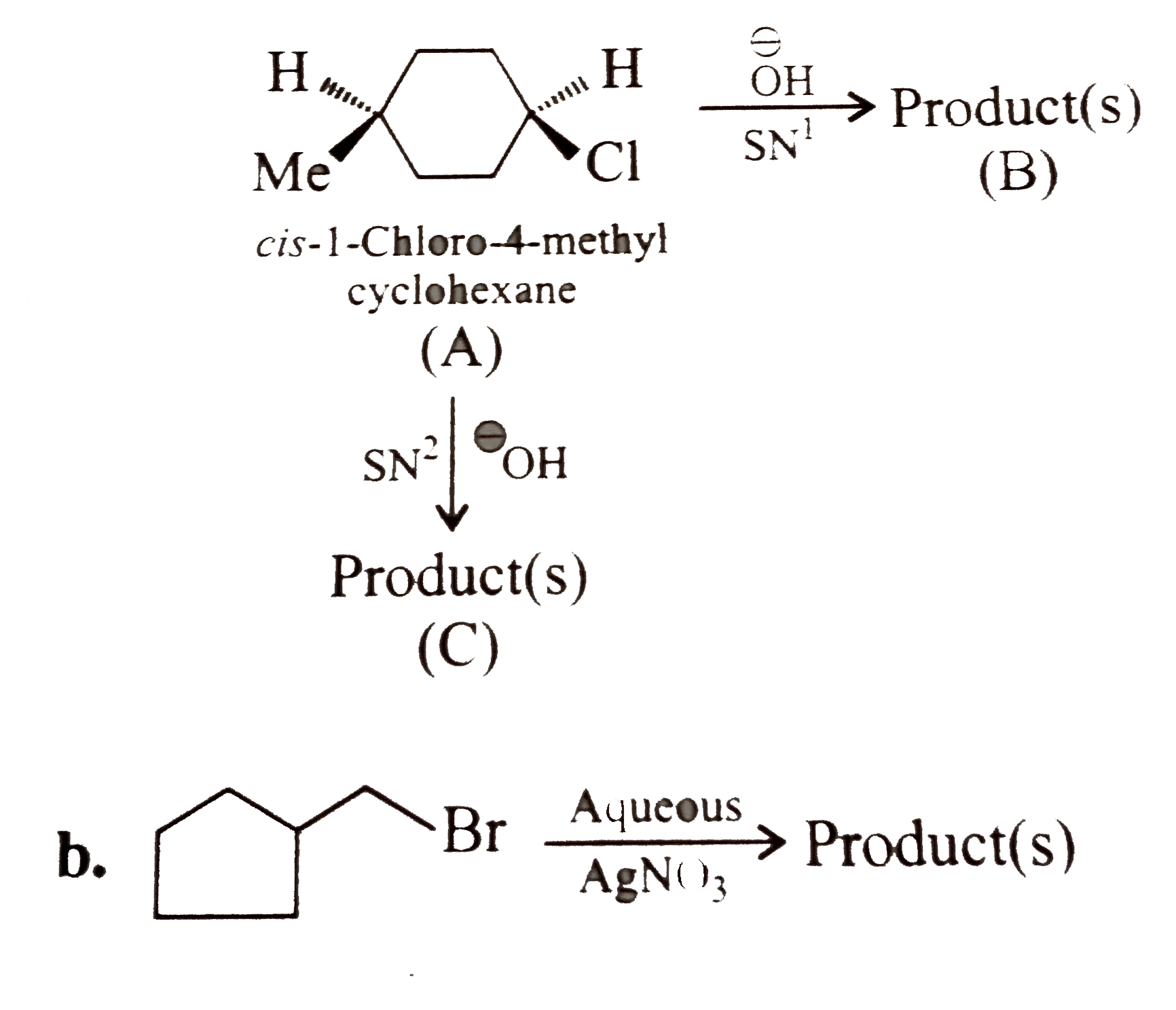
(c) The reaction of `C_2 H_5 OH` with `NaBr` in the presence of `H_2 S O_4` is slow, but when trimethy1 sily1 chloride `(Me_3 SiC1)` is added to it, reaction proceeds very fast. Why ?
View SolutionExplain the reaction :
(a) `ROH + NaBr rarr`
(b) `ROH + HBr rarr`
(c)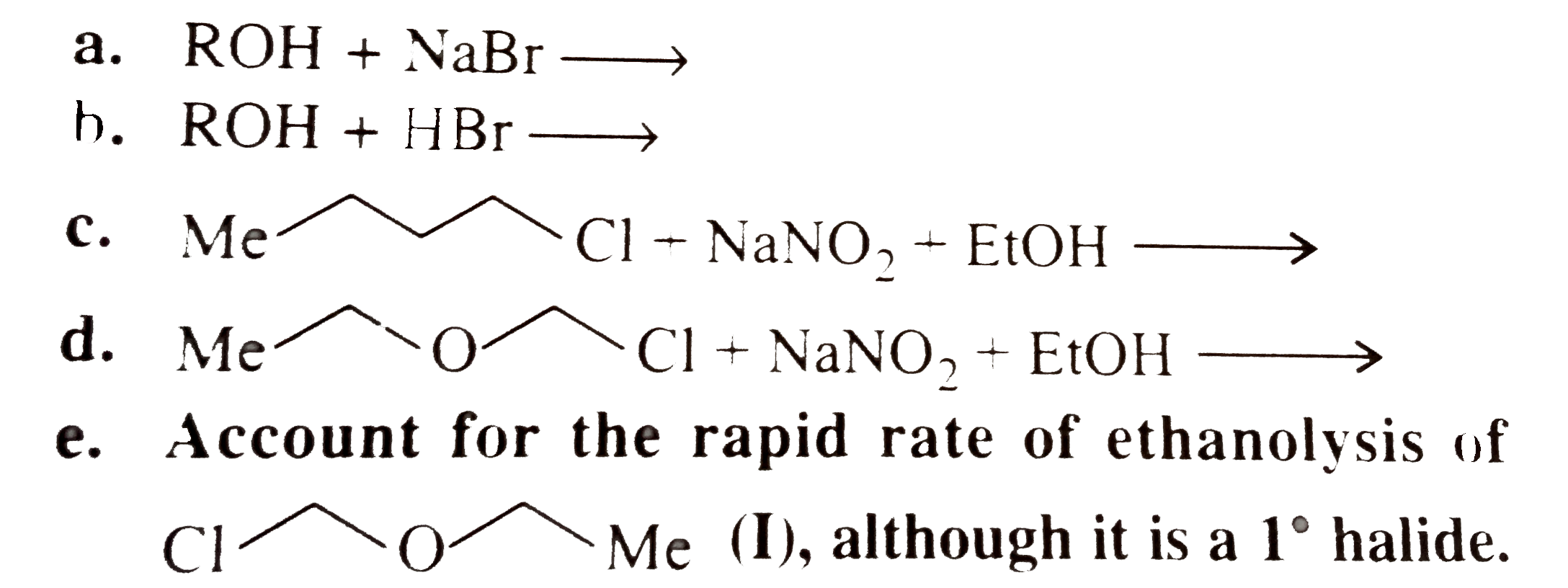
View SolutionGive the organic products of the following reactions :
(a) `nPrBr + underset(ddot)oversetoverset( :O: )(||)(N)-underset(ddot)overset(ddot)(O):^(Theta)`
(b) `i-Pr-Br+| :underset(ddot)overset(ddot)(S)C -= N: |^(Theta) ("Isocyanate")`
(c) `Et-Br+| :underset(ddot)overset(ddot)(S)-SO_(3)|^(2 Theta) ("Thiosulfate")`
(d) `C1(CH_2)_3 I + CN^(Ө)` (One mole each)
(e) `H_2 N(CH_2)_4 Br overset(-H^(oplus))rarr`.
(f) `Me-O-undersetunderset(underset(("Dimethyl sulphate"))(O))(||)overset(overset(O)(||))(S)-O-Me+EtS^(Theta) rarr`
(g) `MeONO_2 ("Methy1 nitrite") + N_3^(Ө) ("From" NaN_3) rarr`
(h) `MeCN + HS^(Ө) rarr`
( i) `Me-O-underset(underset("Methyl fluorosulfonate")(||))overset(overset(O)(||))(S)-F+I^(Theta)rarr`.
View Solution(I) Give the decreasing order of `SN^2` reacivity of the following alkoxide nucleophile.
`Me_3 CO^(Ө), MeCH_2O^(Ө), Me_2CHO^(Ө)`
and (b)
(b) 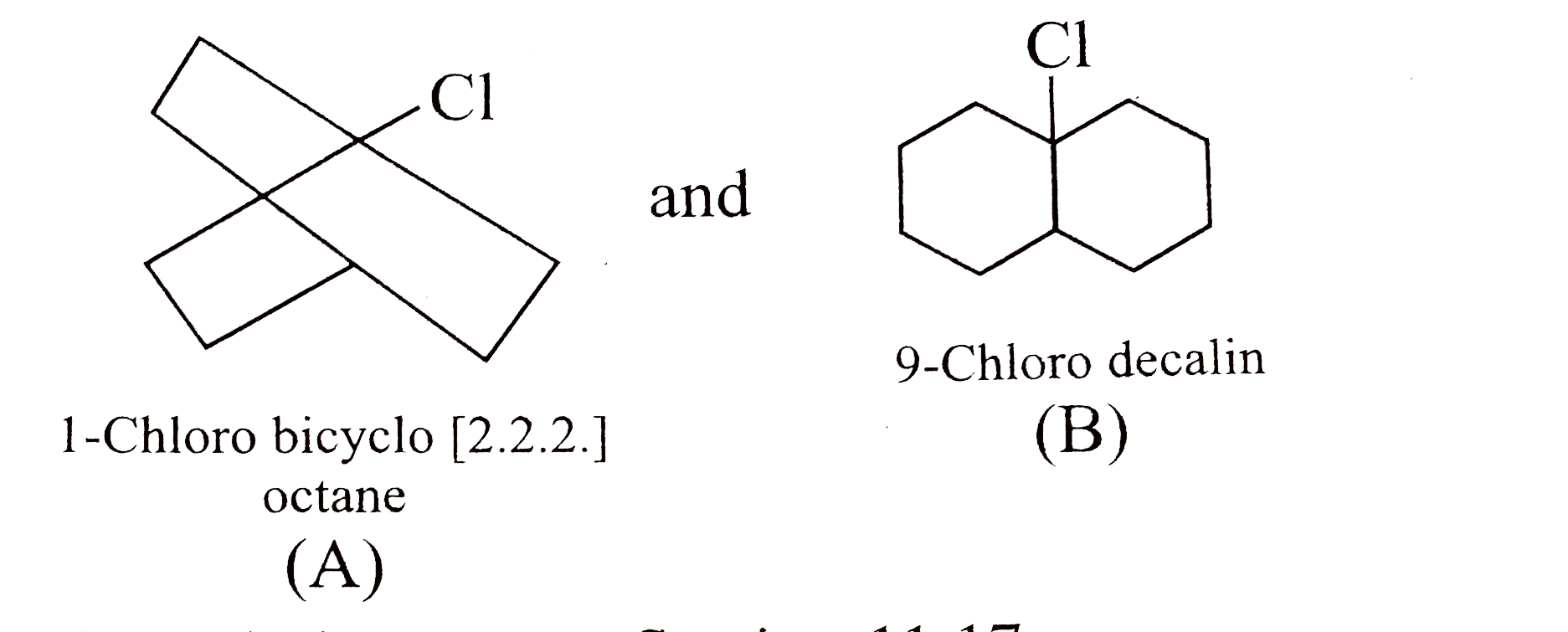 .
.
View SolutionOptically pure `(+)-2` -chlorooctane, `[alpha] = +40^@`, reacts with aq. `NaOH` in acetone to give optically pure `(-)-2` -octanol, `[alpha] = -12.0^@`. With partically racemised chloro compound whose `[alpha] = + 30^@`, the `[alpha]` of alcohal product is `- 6.0^@`. Calculate :
(a) The percentage optical purity of partially racemised chloro compound and alcohol.
(b) The percentage of inversion and racemisation.
(c) The percentage of front-side and back-side attacks.
(d) What interference can be drawn from the data in part (a) of the above example, about the mode of `2^@` alky1 halide.
( e) Give the rate expression.
In terms if the expression, decrease the experimental changes for encourage (i) `SN^1`, (ii) `SN^2`,
View SolutionExplain the sterochemistry of the intermediates and products in the following reaction and give their `R` and `S` configurations.

View SolutionPredict the effect of increasing the percentage of `H_2 O` in acetone `-H_2 O` solvent mixture in :
(a) `SN^1` solvolysis of `Me_3 C - Br`
(b) `SN^2` reaction of `K1` and `EtC1`.
(c) Predict the relative yields of the product of `Me_3 CBr` in `80% EtOH` and `20 % H_2 O`.
View SolutionAccount for the following observations :
(a) `t-BuF` is solvolysed only in very acidic solution.
(b) `t-BuC1` is solvolysed more slowly than 2-chloro-2,3,3,-trimethy1-butane (A).
(c) `t-BuC1` is solvolysed much faster than 2-chloro-1,1,1-trifluoro-2-methy1 propane (B).
(d) `t-BuC1` is solvolysed more slowly in `90 % D_2 O - 10 %` dioxane than in `90 % H_2 O - 10 %` dioxane solution.
View Solution(I) Identify the products of dehydration of following alcohols.
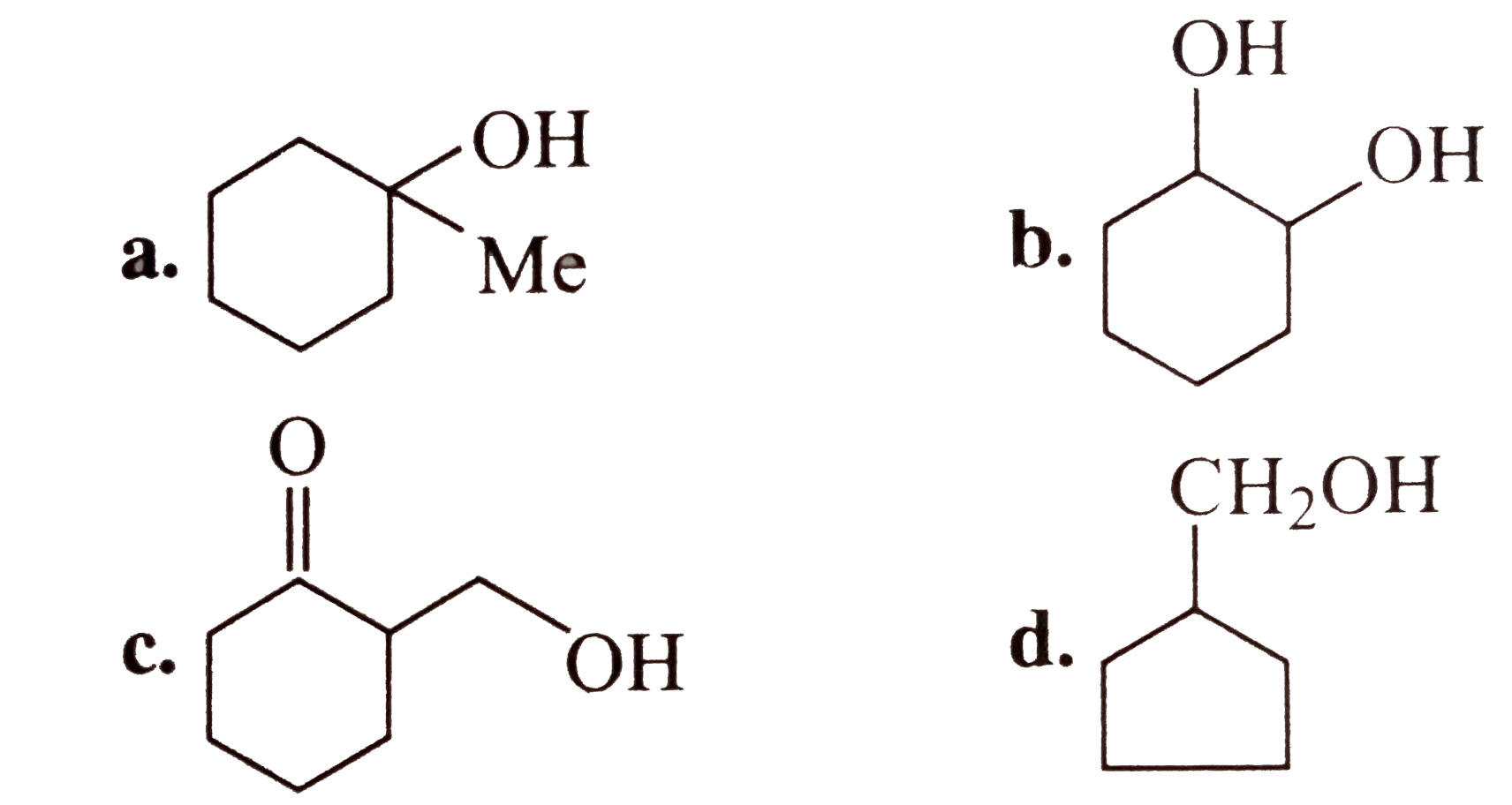
(II) Predict the product and mechanism, `E1, E2`, or `E1cB`.
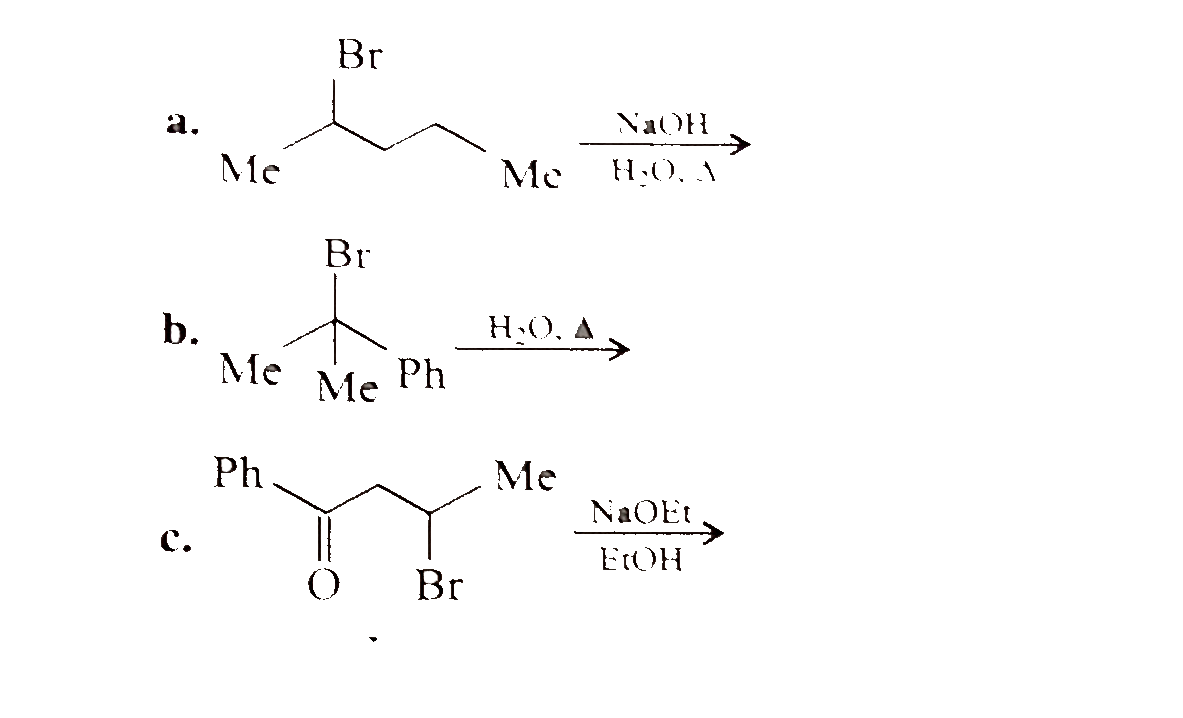
(III) Of the following pairs of structures, choose the componds that better fir the description.
(a) Gives more Saytzeff product in an `E2` reaction
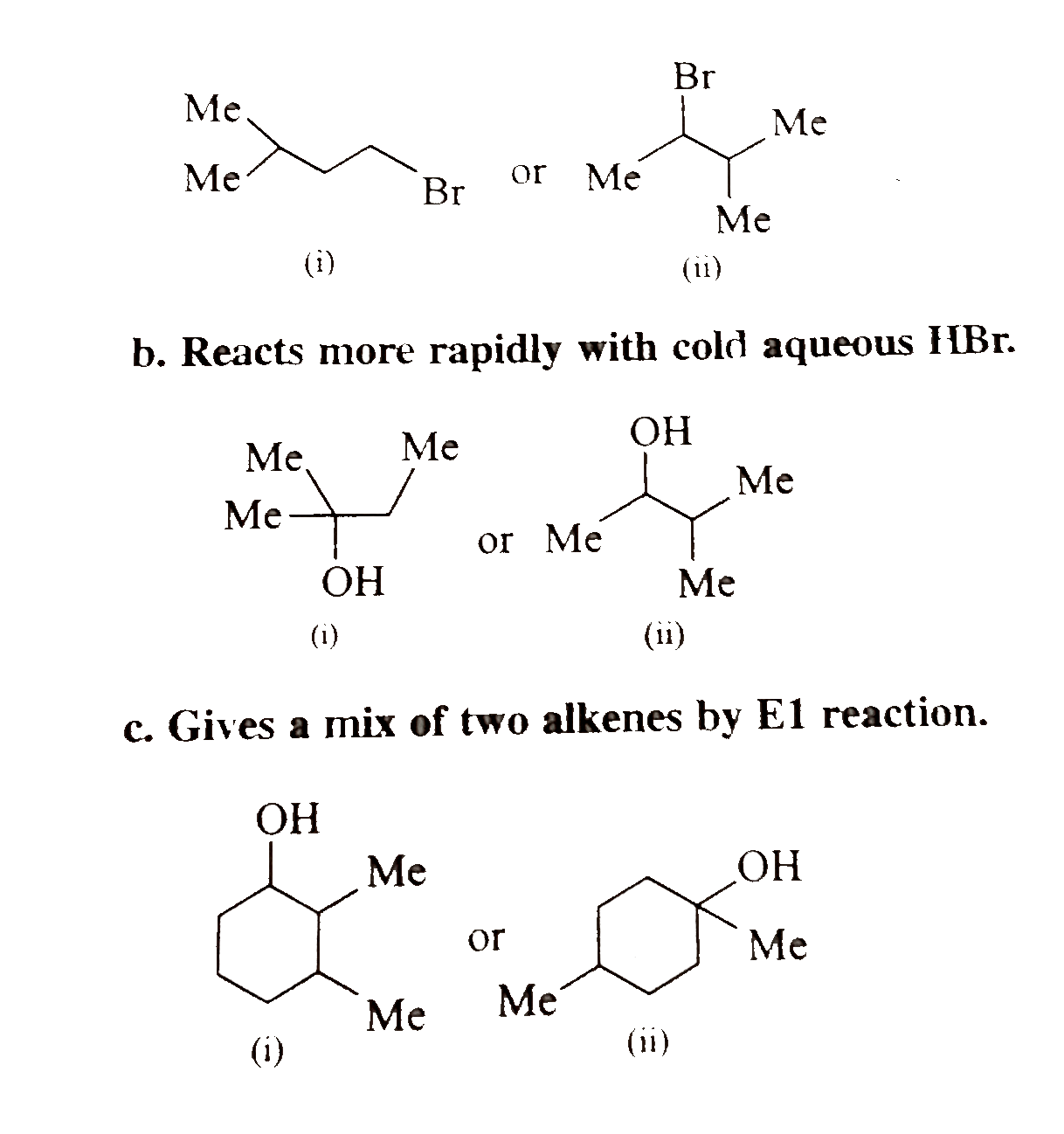
View SolutionGive all the possible major and minor products `(SN^1 and E1)` in the following. Explain.
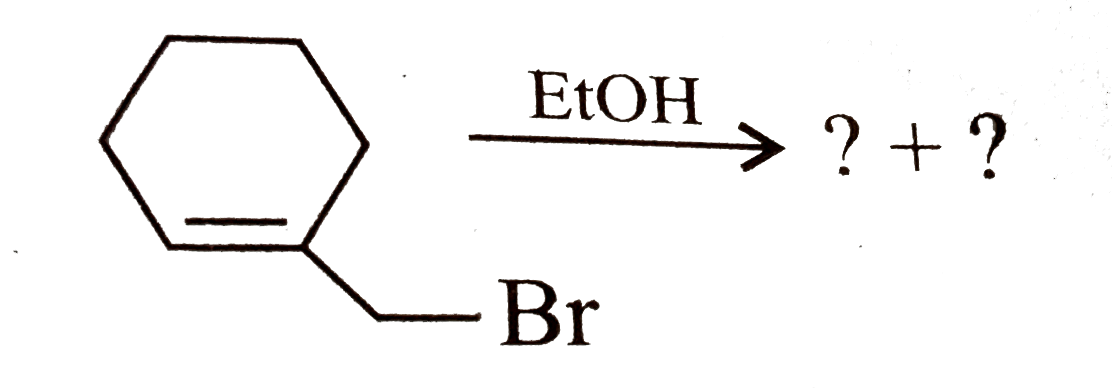
(b) If t-pentyl shloride reacts with `25 % H_2 O` and `75 % C_2 H_5 OH` in `NaOH`, what are the possible products formed ? Explain with mechanism.
View SolutionGive the product and find out which is faster ?
(a) (i) `CH_3 CH_2 I overset (overset (Ө) OH) rarr`
(ii) `D_3 C-CH_2 I overset (overset (Ө) O H) rarr`
(b) Give the product and find out which is faster out of `SN^1` and `E1` and why ?
(i) `(CH_3)_3 C C1 overset (overset (Ө)O H)rarr`
(ii) `(CD_3)_3 C-C1 overset (overset (Ө) O H)rarr`.
View Solution(a) Give the products of the reaction of `KOH` with
(i) `C_4H_9Br`
(ii) `C_2H_5CHBrCH_3`
(iii) `Me_3CBr`
(b) Give the reactivity order.
(c) Give the factors that determine the major product.
View Solution(a) Why does `3^@ RX` rarely undergo `E1` reaction ?
(b) How can `E1` be promoted ?
(c) Give the products in the following reaction.

(d) Give the products of `MeONa` with
(i) cis and
(ii) trans-2-Bromomethy1 cyclohexane.
View Solution(a) Compare the reactivity of `Me_3CO^(Ө)K^(oplus)` and `EtNH_2` in `E2` reaction.
(b) Why is `Me_3CO^(Ө)K^(oplus)` superior to `EtO^(Ө)` in `E2` reaction ?
(c) Compare the effectiveness of `Me_3CO^(Ө)K^(oplus)` in `DMSO` and `Me_3COH` as solvents.
(d) `Me_2C C1C H_2 CH_3 overset (Me_3 CO^(Ө)K^*)rarr` Major alkene.
View SolutionComplete the following and point out the mechanism as `SN^2,SN^1,E1,E2`, or none.
(a) `Me_2C=CHC1 + NaN NH_2`
(b) `CH_3CH_2Br + ddot Pme_3`
(c) `BrCH_2CH_2CH_2Br + I^(Ө)`
(d) `BrCH_2(CH_2)_2CH_2Br + Mg` (ether)
( e) `Me_3 CBr + HCOOH + HCOO^(Ө)` (small amount)
(f) `Me_3 CBr + HCOOH`
(g) `CH_3 CH_2 CH_2 Br + LiA1D_4`.
View SolutionGive the symbol `SN^1, SN^2,E1`, and `E2` (more than one symbol may be used).
(a) Rates are same.
(b) Electrophilic catalysis is possible.
(c) With a given substrate some pairs of these may be concurrent.
(d) Rearrangement of the `R` skeleton may occur.
(e) `R1` reacts faster with `RC1`
(f) `R^(oplus)` are intermediates.
(g) With saturated `R^, s`, a Saytzeff product is always formed.
(h) Reactions are stereospecific.
(i) Reactions are concerted.
(j) Unhindered `1^@ RX` reacts with `NaOEt|EtOH`.
(k) `t-BuBr` reacts with `CH_3 COOH + CH_3 COO^(Ө) Na^(oplus)` (small).
(l) `t-BuBr` reacts with `CN^(Ө)`.
(m) `t-BuBr` reacts in `EtOH`.
(n) `2^@ RC1` reacts with `NaOEt|EtOH`.
(o) `2^@ RC1` reacts with `HCOOH` and has high dielectric constant.
(p) `2^@ RC1` reacts with `I^(Ө)` in acetone.
(q) `MeX` cannot react.
View Solution(a) When cis-2,3-dibromopent-2-ene is hydrogenated with `H_2//Pt`, The product is :
(i) `Meso-2,3` -Dibromopentane
(ii) `(+)2,3` -Dibromopentane
(iii) `(-)2,3` -Dibromopentane
(iv) `(+-)2,3` -Dibromopentane
(b) When trans-2,3-dibromopentane-2-ene is hydrogenated with `H_2//Pt`. The product is :
(i) Meso-2,3 -Dibromopentane
(ii) `(+)2,3` -Dibromopentane
(iii) `(-)2,3` -Dibromopentane
(iv) `(+-)2,3` -Dibromopentane
(c) When `cis-2,3` -dibromopent-2-ene is hydrogenated with Birch reduction. The product is :
(i) Meso-2,3-dibromopentane
(ii) `(+)2,3` -Dibromopentane
(iii) `(-)2,3-` Dibromopentane
(iv) `(+-)2,3` -Dibromopentane
(d) When trans-2,3-dibromopent-2-ene is hydrogenated with `Na + liq. NH_3` + ethanol. The product is :
(i) Meso-2,3-dibromopentane
(ii) `(+)2,3` -Dibromopentane
(iii) `(-)2,3` -Dibromopentane
(iv) `(+-)2,3` -Dibromopentane
(e) When 2-butyne is reduced with Lindlar's catalyst. The product is :
(i) cis-2-Butene
(ii) trans-2-Butene
(iii) Both (i) and (ii)
(iv) None
(f) When 2-Butyne is reacted with `Na + liq. NH_3 + C_2H_5 OH`. The product is :
(i) cis-2-Butene
(ii) trans-2-Butene
(iii) Both (i) and (ii)
(iv) None.
View Solution
Illustration questions and complete solutions for chapter ORGANIC REACTION MECHANISM of CENGAGE CHEMISTRY (HINGLISH) of Class 11